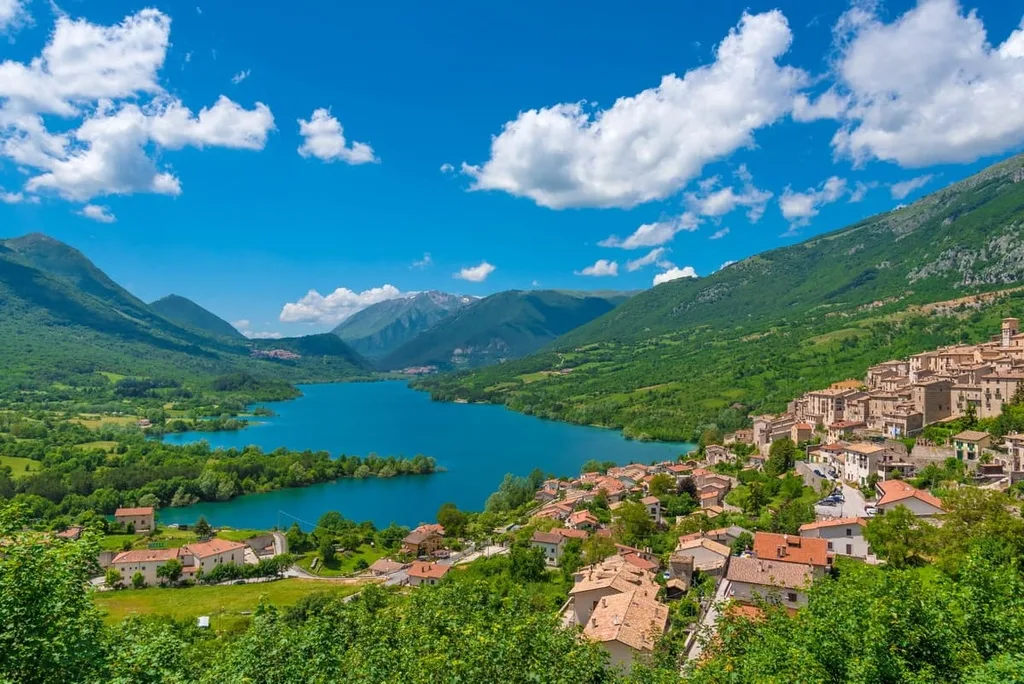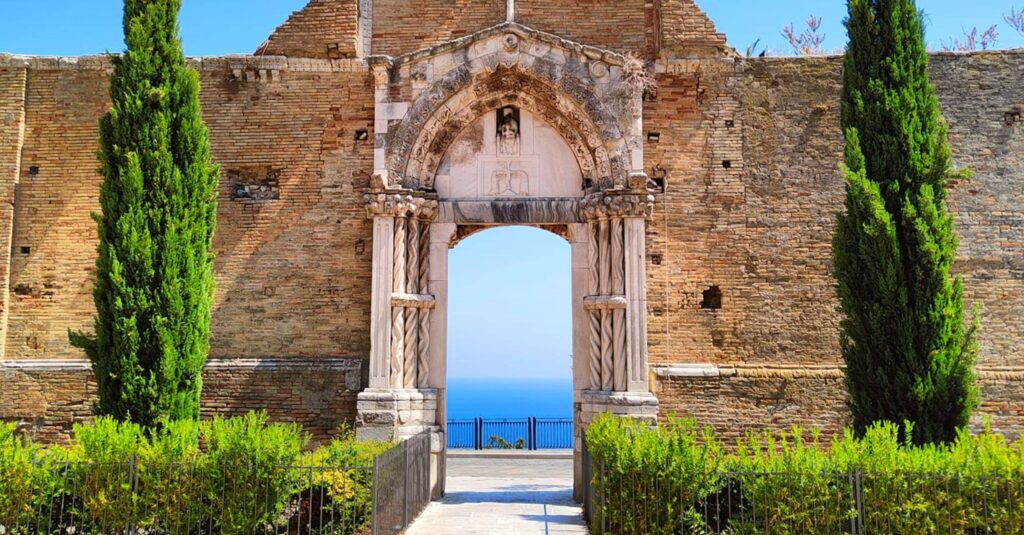Majella rewards curious travellers. It lies in the heart of Abruzzo, between the Peligna Valley and the Adriatic Sea. Expect bold limestone peaks, deep gorges, and ancient hermitages carved into cliffs. Trails range from family‑friendly river walks to serious summit routes. Spa towns, medieval villages, and quiet roads complete the picture.
This guide helps you plan a relaxed and rewarding visit. It highlights the must‑see areas, practical advice, and the best seasons. All tips reflect current park guidance and local insight.

Table of Contents
ToggleThe lay of the land
Majella is a compact alpine world. The massif rises quickly from olive groves to high plateaus. Monte Amaro (2,793 m) is its highest point, and many other peaks exceed 2,000 metres. Karst forms define the landscape: sinkholes, caves, and bare rock ridges. Rivers cut deep canyons with turquoise pools and shaded paths.
The park is also a UNESCO Global Geopark, recognised for its geology and long human story. You’ll find shepherd routes, old quarries, and cliff hermitages linked to Celestine V. Towns on the edges act as natural bases for exploring.
Things to do in Majella National Park
Valle dell’Orfento
This protected gorge is the park’s most loved walk. Wooden bridges cross a clear river under tall cliffs. Moss, ferns, and beech trees keep the air cool in summer.
Know before you go. Free access registration is required. Register at the visitor centre or via QR codes in town. Dogs are not allowed, and bathing is forbidden to protect habitats. Wear sturdy shoes; some sections are rocky and damp.
Top loops and paths:
Scalelle path. Short, shaded, and family‑friendly.
Ponte del Vallone loop. Half‑day with bridges and calm riverbanks.
Higher valley tracks. Longer routes to panoramic balconies and side canyons.
Fara San Martino Gorges
A narrow chasm opens into a limestone corridor. The first section suits most walkers. Beyond it, the trail climbs toward the Vallone di Santo Spirito. Ruins of the old San Martino in Valle Abbey sit near the entrance. Start early for cooler conditions.
Grotta del Cavallone
Reach this cave by the basket‑lift cableway in summer. The ride gives wide views of the Aventino Valley. From the top, a short path and about 280 steps lead to the entrance. Inside, the temperature stays near 10 °C. Bring a light jacket and check seasonal hours before you go.
Hermitages of Majella
Rock sanctuaries hide in side valleys and ledges. Two are easy to reach and deeply atmospheric:
Eremo di San Bartolomeo in Legio. A short walk with sweeping views. The hermitage sits beneath a long cliff band.
Santo Spirito a Majella. The largest complex, open in summer with small exhibits. Paths continue above to panoramic ridges.
These are sacred and fragile sites. Stay on marked paths and pack out all waste.
Wildlife watching
The park symbol is the Apennine wolf. You may never see one, but its presence shapes the ecosystem. Look instead for Apennine chamois near Lama dei Peligni. Golden eagles soar over ridges; deer browse at dawn. Bring binoculars and keep distance from wildlife.
Monte Amaro hike
Monte Amaro is a demanding full‑day climb. Weather changes fast on its plateaus. Carry layers, sun protection, and water.
Main routes:
From Fara San Martino. Long ascent via the Vallone di Santo Spirito.
From Caramanico side. Longer but gentler start.
From Passo Lanciano / Blockhaus. High start, still strenuous.
Attempt only with good fitness and a stable forecast. In winter or early spring, go with a guide.
Blockhaus by bike
Cyclists chase this Giro d’Italia climb. The ascent from Roccamorice is steep but rewarding. Start early, carry layers, and check wind before riding. Parking is limited near the top.
Where to stay and base yourself
Caramanico Terme (west side). Spa town near the Orfento gorge. Small hotels and B&Bs near cafés. Best for hikers and families. Parking is on the edge of the old centre.
Pacentro & Sulmona (west gateway). Pacentro is scenic and quiet. Sulmona offers more rooms and better transport. Both are ideal for non‑drivers. Note ZTL limits in historic cores.
Lama dei Peligni (east side). Calm base with a botanical garden and visitor centre. Good for wildlife watching and day trips to caves and gorges. Expect simple guesthouses and agriturismi.
Fara San Martino. Handy for the gorges at dawn. Small hotels, apartments, and local trattorie sit near trailheads. Easy parking and quick trail access.
Roccamorice. Close to the road to Blockhaus. Ideal for cycling and hermitage walks. Rooms are limited, so book early in summer.
Pescocostanzo. Alpine feel with meadows and beech woods. Family hotels and inns. Ideal in autumn for colour and easy loops.
Countryside agriturismi. Farm stays dot the lower slopes. Expect home cooking, parking, and quiet nights. You’ll drive to trailheads.
Booking tips. Reserve early for August and autumn weekends. Ask about parking and breakfast times. Check heating or air‑conditioning in shoulder seasons.
Seasons and when to visit
Spring (April–June). Rivers run clear. Wildflowers cover meadows. Snow may linger high into May.
Summer (July–August). Hot in lowlands, pleasant in gorges and woods. Start early to avoid heat and crowds.
Autumn (September–November). Stable weather, crisp air, and golden forests like Bosco di Sant’Antonio.
Winter (December–March). Great for snowshoeing and ski‑touring. Expect icy paths and road closures after storms.
Park rules and tips
Valle dell’Orfento access registration required. Free and quick at visitor centres or QR signs.
Stay on marked trails. Karst terrain hides sinkholes.
No bathing, no stone stacks. Protect habitats.
No dogs on protected gorge routes.
Take rubbish with you. Few bins at trailheads.
Grotta del Cavallone. Open June–September, weather permitting.
Carry water and sun protection. High plateaus lack shade.
Drive slowly. Roads are narrow and scenic.
Family‑friendly walks
Scalelle path, Orfento. Short and shaded.
San Bartolomeo hermitage. Manageable ascent, rewarding views.
Bosco di Sant’Antonio. Easy forest loops.
Fara San Martino gorge entrance. Flat start, turn back when steep.
Classic day hikes
Ponte del Vallone loop. Bridges and forest light.
Vallone di Santo Spirito. Canyon walk into high country.
Santo Spirito ridges. Big views over the Adriatic.
High‑plateau traverses. Only in stable weather with a map.
Multi‑day: Sentiero dello Spirito
The Spirit Trail links hermitages over several days. Expect rugged tracks and big elevation gains. Plan stages around villages for food and lodging. It reveals Majella’s spiritual heart.
Visitor centres
Paolo Barrasso Centre (Caramanico Terme). Trail advice, Orfento registration, and museum.
Lama dei Peligni centres. Info, botanical garden, and chamois area.
Local info points in Pacentro, Fara San Martino, and Roccamorice.
Getting there
By air. Fly to Pescara Airport. Rent a car for trail access.
By train/bus. Sulmona is the main rail hub. Buses reach Pacentro and Caramanico Terme; summer lines connect to Lama dei Peligni and Fara San Martino.
By car. Scenic, winding roads—drive slowly and enjoy the views.
Safety notes
Weather shifts quickly on the massif. Check forecasts, carry layers and water, and inform someone of your plan. Phone coverage is limited. Treat winter terrain as alpine and hire a certified guide when needed.
FAQs
Do I need a permit for Valle dell’Orfento?
Yes, free access registration via visitor centre or official QR codes.
Can I visit Grotta del Cavallone without hiking?
Yes, take the basket‑lift and climb about 280 steps to the entrance. Inside temperature ~10 °C.
What is the best base town?
Caramanico Terme for Orfento trails, Lama dei Peligni for chamois areas, Fara San Martino for gorges.
How hard is Monte Amaro?
Long and exposed; go only with good fitness and clear weather.
Is Majella UNESCO‑listed?
Yes, as a UNESCO Global Geopark for its geology and culture.
Responsible travel
Support small family hotels and local guides. Refill bottles in towns. Stay quiet near hermitages. Buy cheese, honey, and olive oil from village producers.
Plan your visit
You might also explore other corners of Abruzzo after Majella—Gran Sasso National Park for alpine peaks, or the medieval villages of Scanno, Pacentro, and Santo Stefano di Sessanio for timeless charm.
Save this guide, mark your hikes, and sketch a two‑ or three‑day itinerary. Begin with Valle dell’Orfento, add a hermitage walk, and keep one day flexible. For a summit, hire a guide and climb Monte Amaro. Majella will greet you with quiet trails, big skies, and the scent of beech and thyme.
Disclosure: This page may contain affiliate links. This means that we get a small commission from any purchase you make, at no additional cost to you!

